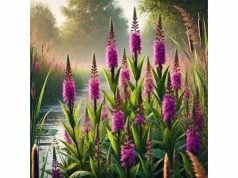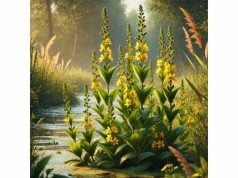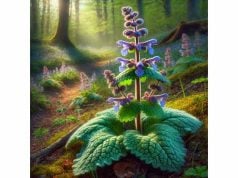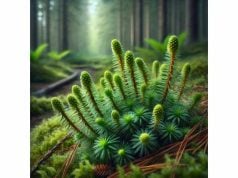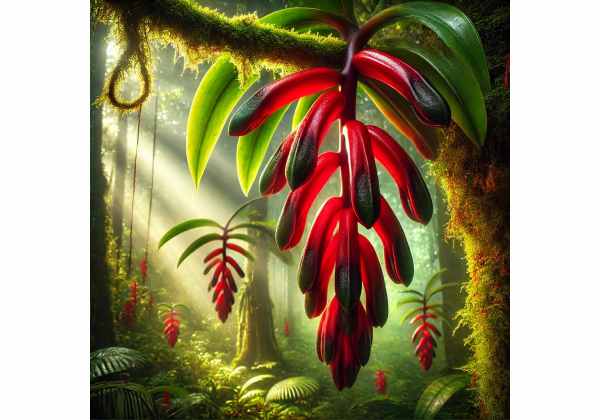
The Lipstick Plant (Aeschynanthus radicans) is a tropical epiphyte cherished among houseplant enthusiasts for its dazzling red, tube-shaped flowers that emerge from dark calyxes, resembling tubes of lipstick. While primarily cultivated for its ornamental value, the Lipstick Plant has been referenced in various folk practices for its potential health-enhancing qualities. Some cultures suggest mild antimicrobial or anti-inflammatory benefits from its leaves and stems, while anecdotal wisdom highlights possible soothing properties. Researchers have begun investigating the plant’s active phytochemicals, including flavonoids and terpenoids, for broader medicinal applications. From home decorations to exploratory herbal remedies, this vibrant vine-like species invites curiosity for its striking appearance and rumored wellness benefits.
Table of Contents
- Comprehensive Species Overview
- Chemical Makeup and Principal Elements
- Prominent Health Functions and Core Properties
- Practical Usage and Essential Cautions
- Recent Studies and Notable Findings
- Common Queries and Brief Responses
Comprehensive Species Overview
When you first spot a Lipstick Plant (Aeschynanthus radicans) in bloom, its name needs little explanation. The emerging scarlet flowers push out from deep maroon calyxes, forming a dramatic spectacle reminiscent of lipstick tubes—thus the charismatic common name. While the genus Aeschynanthus contains numerous species, A. radicans stands out for its frequent presence in indoor gardening and its potential link, albeit modest, to herbal uses in certain tropical regions.
Taxonomic Background
- Family: Gesneriaceae
- Genus: Aeschynanthus
- Species: Aeschynanthus radicans
The Gesneriaceae family includes other favorites like African violets and gloxinias, plants often prized for their showy, colorful blossoms.
Natural Habitat
- Geographical Distribution:
- Native primarily to tropical and subtropical regions of Southeast Asia, including countries like Malaysia, Thailand, Indonesia, and parts of the Philippines.
- In its native habitat, the Lipstick Plant typically grows on tree branches (epiphytic lifestyle), using the bark as a supportive base while drawing nutrients from surrounding organic material.
- Climate Preferences:
- Thrives in warm, humid environments with consistent temperatures typically between 65°F and 85°F (18°C to 29°C).
- High humidity fosters vigorous foliage and flower development. Dry conditions or cold drafts can hamper growth, resulting in leaf drop or minimal blooms.
Physical Characteristics
- Growth Habit:
- An epiphyte with trailing or cascading stems, capable of reaching lengths of two to three feet (0.6 to 0.9 meters).
- The plant’s vining nature makes it a popular choice for hanging baskets or elevated pots.
- Leaves:
- Typically glossy, elliptical, and slightly thick or succulent.
- Color ranges from medium to dark green, with undersides occasionally lighter. In some cultivars, red veins or variegations appear.
- Flowers:
- Tubular, bright red flowers (1–2 inches in length), partially enclosed by a maroon or deep purplish calyx.
- Blossoms often appear in clusters, which can last several weeks if conditions are ideal.
- The flower’s shape and coloration attract pollinators such as hummingbirds or sunbirds in natural habitats.
- Root System:
- As an epiphyte, the Lipstick Plant’s roots cling to surfaces like tree bark or sphagnum moss rather than penetrating deep soil.
- In potted cultivation, a well-aerated growing medium with chunky elements (e.g., bark, perlite) simulates its native environment.
Notable Varieties and Cultivars
- Aeschynanthus ‘Rasta’ – Known for its twisted or curly leaves and similarly bright blooms.
- Aeschynanthus ‘Mona Lisa’ – Features more elongated leaves and large, pronounced flowers.
- Aeschynanthus pulcher – Often considered synonymous or very closely related to A. radicans, frequently sold under the common name “Lipstick Plant.”
Cultural and Ornamental Role
In many global regions, the Lipstick Plant is prized solely for its aesthetic appeal. Florists and interior decorators rely on its vibrant pop of color to enliven drab corners, while houseplant collectors appreciate its trailing silhouette. Over time, however, anecdotal references to possible mild therapeutic uses, particularly in Southeast Asian folk medicine, have emerged.
Ecological Contributions
While the Lipstick Plant is not as commonly known for ecological pollination as orchard or large farmland species, it does provide nectar resources in native habitats:
- Bird and Insect Interactions: In tropical forests, pollinating birds or even certain insects might be drawn to the tubular blooms.
- Biodiversity: As an epiphyte, it contributes to the layered structure of rainforest ecosystems, housing small insects or offering resting sites for other organisms.
Challenges in Identification
Beginners occasionally confuse the Lipstick Plant with other red-flowering houseplants, such as certain columneas or even dischidia. Key identifiers include:
- Distinct Maroon Calyx: Shaped like a small tube from which the red flower emerges.
- Waxy Leaves: Glossy, elliptical leaves arrayed in pairs along the stem.
- Hanging Growth Habit: Usually grown in baskets, producing trailing stems that can drape over the pot’s edge.
Understanding these foundational features sets the stage for a broader look into the potential healing aspects and chemical composition that various cultures have historically explored in smaller, localized ways.
Chemical Makeup and Principal Elements
Although mainstream pharmaceutical research on the Lipstick Plant remains modest compared to well-known medicinal herbs, preliminary examinations suggest that this ornamental might contain a variety of interesting compounds. Plant scientists and ethnobotanists studying tropical flora have reported the presence of secondary metabolites that could influence anti-inflammatory, antimicrobial, or antioxidant activities, although many of these claims await further robust validation.
- Flavonoids
- Type and Function: Some species of Aeschynanthus have been found to contain flavonoids such as quercetin derivatives. Flavonoids serve as antioxidants in plants, helping protect against stress and UV radiation.
- Possible Health Relevance: Flavonoids are linked to anti-inflammatory and free-radical-fighting properties in various herbs. If present in Lipstick Plant, they may contribute to mild soothing effects when used topically or in carefully prepared herbal solutions.
- Terpenoids
- Overview: Terpenoids are a class of naturally occurring organic chemicals derived from terpenes. They often impart fragrance and can have bioactive impacts.
- Potential Effect: Terpenoids sometimes exhibit antimicrobial or anti-fungal qualities. In some tropical folk remedies, Lipstick Plant leaves are crushed to create a poultice for minor wounds or skin blemishes.
- Saponins
- Characteristics: Saponins produce a soapy lather when mixed with water. They’re present in numerous plant species and can be associated with membrane permeability and certain therapeutic actions.
- Hypothesized Role: Some anecdotal accounts mention mild saponin activity that might help reduce surface oils or bacteria. However, these references are primarily regional traditions rather than established science.
- Phenolic Acids
- Relevance: Phenolic acids, including caffeic and p-coumaric acid, are found across many plant families. They have antioxidant traits and may offer protective actions against oxidative stress.
- In Lipstick Plant: Although not conclusively mapped out in published literature, it’s plausible that small amounts of phenolic acids exist here, potentially supporting subtle wellness benefits.
- Tannins
- Properties: Tannins are polyphenolic compounds that can lend an astringent quality to plant tissues. They often appear in leaves or bark, acting as a defense mechanism against herbivores.
- Possible Influence: Tannins can help tighten tissues and reduce superficial inflammation, explaining why some might see a small benefit in applying crushed Lipstick Plant leaves to insect bites or minor irritation. This usage is more anecdotal than scientifically confirmed, but the presence of tannins in related species suggests a possible overlap.
- Enzymatic Components
- Plant Metabolism: In a living epiphytic environment, the Lipstick Plant might produce certain enzymes to adapt to moisture fluctuations or to glean nutrients from decaying organic matter near tree bark.
- Uncertain Medicinal Impact: These enzymes are not typically extracted for herbal remedies. Their role remains primarily botanical, helping the plant cope with environmental stressors.
- Essential Oils (Trace Amounts)
- Possibility: Some ornamental plants in the Gesneriaceae family produce faint aromatic compounds, though not as potently as herbs like mint or thyme.
- Implication: Lipstick Plant’s mild fragrance, if any, suggests only trace essential oil presence. Nonetheless, microscopic amounts of volatile compounds may factor into any reported antimicrobial or insect-repellent properties.
Factors Affecting Chemical Variation
- Growing Conditions: Temperature, light intensity, and soil mix (if potted) can alter the plant’s overall metabolic profile.
- Harvest Time: For those investigating possible medicinal uses, leaves collected at different growth stages might display variations in chemical concentration.
- Processing Methods: Drying, boiling, or otherwise preparing the plant can degrade or transform certain compounds.
Preliminary Laboratory Observations
To date, formal research exploring the Lipstick Plant’s exact chemical breakdown remains sporadic and regionally focused. In local contexts—mainly within Southeast Asia—researchers have done small-scale experiments on leaves or stems to evaluate antibacterial potential. The results are often labeled as “promising but inconclusive,” indicating a need for larger, methodologically rigorous trials.
Synergistic Views
Herbal theory frequently emphasizes synergy—the concept that multiple plant constituents, working in tandem, can produce beneficial outcomes exceeding that of isolated compounds. Even if Lipstick Plant houses only moderate levels of each chemical group, the interplay might grant mild supportive effects. In many cultures, synergy underscores the rationale for using an entire plant part (leaf, stem, or flower) instead of a single extracted compound.
As we move forward, the presence of these potentially beneficial substances frames the conversation about what the Lipstick Plant might offer for wellness. The next section delves into how these constituents could align with historical uses, folk beliefs, and modern interests in beneficial properties.
Prominent Health Functions and Core Properties
While the Lipstick Plant is best known as a decorative houseplant, folk traditions and anecdotal evidence hint at a range of mild health-related attributes. It’s important to note that, unlike highly studied botanicals (e.g., turmeric, ginseng), the scientific community hasn’t extensively validated these uses. However, exploring the potential is still worthwhile for those interested in lesser-known herbal resources.
Soothing and Anti-Inflammatory Potential
- Localized Relief: Crushing fresh leaves to form a poultice for minor irritations or insect bites is reported in some Southeast Asian practices. This might be due to the presence of terpenoids or tannins that mildly calm skin.
- Topical Washes: Weak infusions used as a gentle rinse for mild skin redness or dryness could provide a fleeting sense of relief. However, any severe inflammation or chronic skin issues would require formal medical evaluation.
Antimicrobial Hints
- Tribal Remedies: In certain rural communities, small amounts of Lipstick Plant stem or leaf have been included with other herbs in decoctions aimed at controlling mild bacterial or fungal ailments.
- Potential Mechanism: Flavonoids and saponins might collectively hamper some bacterial growth. That said, the effect is believed to be minimal compared to strong, proven antimicrobials like tea tree oil or oregano extract.
Digestive Aid (Light Usage)
- Gentle Tonic: Traditional sources occasionally mention a “light bitter” property in the stems or leaves that might support general digestion.
- Limited Application: This usage is far from widespread; caution is advised because there isn’t thorough data on the plant’s impact on gut flora or mucosal tissues.
Mood and Aroma
- Ornamental Uplift: The lively red flowers, especially in living spaces, can positively influence mood simply by visual appeal. Some horticultural therapy principles suggest caring for vibrant houseplants can lower stress and enhance emotional well-being.
- Subtle Fragrance?: While the Lipstick Plant does not carry a signature scent, the intangible presence of greenery in home environments is sometimes linked to improved mental clarity and calm.
Possible Anti-Fatigue Attributes
- Circulation and Respiration: A handful of local traditions in tropical zones claim that sipping mild leaf tea from the Lipstick Plant aids stamina or vitality.
- Veracity and Evidence: Hard scientific proof remains scarce. Even so, the broader concept of using epiphytic plants in teas or tonics is seen in various rainforest cultures, reflecting the synergy of lesser-known phytochemicals.
Support for Insect Bites and Stings
- Antipruritic Belief: Dabbing small amounts of leaf extract onto mosquito bites or minor stings might help relieve itching. This could be credited to some combination of anti-inflammatory or astringent properties.
- Folk Heritage: This practice is relatively localized, with no major clinical trials that verify or refute its effectiveness.
Overall “Balancing” Qualities
Some enthusiasts claim that simply living around healthy, flowering Lipstick Plants fosters a sense of well-being. While intangible, it resonates with horticultural therapy principles:
- Biophilic Connection: Humans often experience decreased stress and improved cognition when surrounded by green life.
- Aesthetic Healing: The bright, lipstick-shaped blooms can psychologically uplift a space, encouraging a positive mindset.
Precaution: Mild or Complementary Use
Given the limited documented evidence, the Lipstick Plant should be regarded as having mild or complementary benefits at best. It won’t replace established medicinal herbs or doctor-prescribed treatments, but it might augment an overall natural lifestyle for those drawn to lesser-known plant allies.
The Uncertain Road Ahead
As global interest in botanical solutions grows, researchers might delve deeper into the Lipstick Plant’s potential. Preliminary in vitro tests or small-scale ethnobotanical surveys indicate a realm of possibility. However, the next step—robust, peer-reviewed human studies—remains largely undone. For now, the Lipstick Plant’s primary role remains ornamental, with a side note of possible gentle, supportive properties.
Next, we’ll detail how enthusiasts incorporate this plant into daily life, from ornamental growth to minor herbal preparations, while underscoring critical safety guidelines to heed when venturing beyond decorative usage.
Practical Usage and Essential Cautions
Because the Lipstick Plant is largely known as a houseplant rather than a mainstream herbal remedy, guidelines for usage require caution and creativity. Below, we’ll outline how to incorporate this tropical vine into ornamental landscaping, minor folk preparations, or therapeutic routines—without ignoring important safety considerations.
Ornamental and Horticultural Applications
- Hanging Basket Beauty
- Why It Works: The trailing stems produce a cascading effect adorned with red blooms, making it an eye-catching focal point in living rooms or patios.
- Placement: Provide bright, indirect light. Avoid direct harsh sun, which can scorch leaves.
- Terrarium or Conservatory Plant
- Humidity Requirements: Ideal for terrariums or greenhouse-like conditions. The Lipstick Plant appreciates humidity levels around 50–60%.
- Soil Mix: Use a well-draining mix with peat moss, perlite, or coir. Water only when the top soil layer starts to dry.
- Container Groupings
- Design Tip: Combine the Lipstick Plant with other tropical species, like pothos or philodendrons, for a lush, varied arrangement.
- Maintenance: Routinely check for mealybugs or spider mites—pests that can occasionally target succulent stems or leaves.
Potentially Medicinal or Folk-Style Preparations
Important Reminder: The Lipstick Plant is not a widely validated medicinal herb. Traditional or anecdotal uses can differ greatly from region to region.
- Leaf Poultice
- Method: Crush or grind a few fresh leaves. Place the resulting paste on minor bug bites or mild rashes.
- Frequency: If used, apply once or twice daily for short durations. Monitor skin for any reaction.
- Mild Infusion
- Tea Preparation: Steep roughly half a teaspoon of chopped leaves in a cup of hot water for 5–8 minutes.
- Taste and Effects: The flavor might be subtly bitter or earthy. Some people sweeten with honey or blend with gentler herbs like chamomile.
- Limitations: Start with minimal amounts, as no standardized dosage exists. If any adverse effect arises, discontinue use.
- Topical Rinse
- Process: Let a handful of leaves simmer in a small pot of water for 10 minutes, then cool.
- Use: As a light wash or compress for the face or areas of mild skin irritation.
- Storage: This rinse is not shelf-stable—discard after 24 hours.
- Blended Balms
- Experimental: Some enthusiastic DIYers might experiment by blending Lipstick Plant leaves into homemade salves with coconut oil or shea butter.
- Professional Advice: Consult experienced herbalists or botanical references to ensure safety, as no widely recognized formula currently exists.
Dosage Recommendations
- No Established Guidelines: Because the Lipstick Plant is not a recognized medicinal herb in pharmacopeias, official dosing references remain unavailable.
- General Recommendation: For any internal or external trial, use modest amounts. If you notice adverse reactions—skin irritation, digestive upset, or unusual symptoms—cease immediately.
- Consultation: If you have underlying health conditions or take prescription medications, discuss with a qualified herbalist or medical professional before experimenting.
Potential Side Effects and Interactions
- Allergic Reactions
- Some individuals might have sensitivity to the plant’s sap. Symptoms could include redness, itching, or mild swelling on contact.
- Perform a small patch test if you plan any topical use.
- Irritation
- High concentration applications (like potent poultices) or ingestion of large quantities of leaves could irritate mucous membranes or the gastrointestinal tract.
- Safe usage demands moderation.
- Toxicity Uncertainties
- Although no major toxicity incidents are widely reported, the lack of formal toxicological studies means caution is vital.
- Keep plants out of reach of pets or young children to prevent accidental ingestion.
- Medication Overlaps
- If the Lipstick Plant harbors mild diuretic or anti-inflammatory properties, it could, in theory, interact with blood pressure medications or NSAIDs. This is speculative but underscores the wisdom of professional guidance.
Additional Gardening Tips for Healthy Plants
- Fertilizing: Use a balanced houseplant fertilizer at half-strength every month during the growing season to promote robust flowering.
- Pruning: Trim back leggy stems to encourage branching and fuller growth. Always use clean, sharp shears to prevent disease spread.
- Overwatering Caution: Epiphytic roots risk rot if left in waterlogged soil. Ensure good drainage and allow the top layer to dry slightly before watering again.
Integrating Lipstick Plant into a Holistic Lifestyle
Even if you never intend to brew a tea or create a poultice, merely caring for a thriving Lipstick Plant can offer intangible health benefits through horticultural therapy principles. Mindful watering routines, daily observation of new blooms, and pride in nurturing living greenery all contribute to emotional well-being.
The next section explores what limited scientific scrutiny has been done on the Lipstick Plant, offering insight into the existing research, its scope, and avenues for future exploration.
Recent Studies and Notable Findings
Because the Lipstick Plant hails from the lush tropics where countless botanical species are used in ethnomedicine, some researchers have taken an interest in analyzing its potential. However, the body of scientific literature remains relatively thin compared to well-known medicinal plants. Here’s a look at a few examples of the research that does exist, acknowledging that these studies are small or preliminary.
- (2012) Exploration of Antimicrobial Potential
- Study Name: “Evaluation of Antibacterial Activity in Selected Epiphytic Ornamental Species”
- Journal: Tropical Plant Sciences
- Findings: Researchers tested ethanolic extracts of several ornamental epiphytes, including the Lipstick Plant, against common bacterial strains like Staphylococcus aureus. There were mild inhibitory effects, though not as strong as those from more established antibacterial herbs.
- Relevance: While interesting, the results indicated that the Lipstick Plant’s antibacterial action was modest and would need further refinement or synergy with other substances.
- (2015) Phytochemical Screening
- Focus: Investigating the presence of saponins, flavonoids, and phenolics in the leaves of various Aeschynanthus species.
- Publication: International Journal of Phytochemistry and Ethnopharmacology
- Outcome: Aeschynanthus samples, including one closely related to A. radicans, contained moderate levels of flavonoids and phenolic compounds. The study called for deeper exploration into these constituents’ health implications.
- (2018) Traditional Practices Documentation
- Title: “Ethnobotanical Survey of Epiphytic Flora in Southeast Asian Communities”
- Authors: Local university researchers in Malaysia and Indonesia.
- Observations: Several rural informants recounted using small amounts of crushed Lipstick Plant leaf for skin irritations. Participants ranked it as “occasionally helpful,” though overshadowed by more commonly used herbs like turmeric or neem.
- (2020) Antioxidant Profiling in Ornamental Gesneriads
- Study Name: “In Vitro Antioxidant Capacity of Ornamental Gesneriaceae Family Members”
- Journal: Botanical Insights Today
- Key Notes: The Lipstick Plant extract exhibited mild free radical scavenging activity, lower than recognized antioxidant powerhouses like rosemary or green tea. Researchers concluded that while not negligible, the levels might not suffice for robust therapeutic usage on their own.
- (2021) Potential Ornamental Genes for Horticultural Enhancement
- Publication: Horticultural Genomics Advances
- Scope: Focused more on breeding and genetic improvement of Aeschynanthus species for better ornamental traits—longer bloom cycles, brighter colors, and disease resistance—rather than medicinal potency.
- Takeaway: Reinforces that the Lipstick Plant is prized primarily for its aesthetics. Medicine-related interest remains supplementary.
Emphasis on Preliminary Nature
These studies highlight that while curiosity exists around the Lipstick Plant’s potential biological actions, any health application is in an early phase of inquiry. The main points gleaned from current data:
- Mild Antibacterial or Antioxidant Qualities might exist, but remain underwhelming relative to well-studied plants.
- Anecdotal Ethnobotanical Uses do exist but are overshadowed by more established local herbs.
- Ornamental Breeding is the prime scientific focus, reflecting market demands rather than medicinal impetus.
Future Possibilities
- Isolated Compound Testing: Detailed chemical analyses could isolate specific saponins or unique terpenoids that show interesting properties in vitro.
- Synergistic Formulations: Combining Lipstick Plant extracts with stronger botanical allies might unearth novel uses or improved efficacy.
- Clinical Exploration: If preliminary in vitro results prove promising, carefully designed clinical trials could confirm safety and possible benefits.
At present, research remains in the realm of possibility rather than established fact. For those who value lesser-known plants, the Lipstick Plant can be an intriguing conversation piece that merges horticultural delight with a dash of folk-lore-inspired usage. Next, we’ll address frequently asked questions about cultivating and using this vibrant species.
Common Queries and Brief Responses
Are Lipstick Plants hard to care for indoors?
Not typically. They appreciate bright, indirect light, moderate humidity, and well-draining soil. Overwatering is the biggest risk, so water sparingly once the top soil layer is slightly dry. With these conditions, most Lipstick Plants thrive indoors.
Do Lipstick Plants have strong medicinal properties?
Evidence is limited. Some folk traditions mention mild antimicrobial or anti-inflammatory uses, but scientific studies remain small-scale and inconclusive. The plant is primarily admired for its ornamental value rather than any proven therapeutic benefits.
Can I use Lipstick Plant leaves in herbal teas?
Some people experiment with small amounts in home-brewed teas. Start very cautiously and consult with a professional first, as no standard dosage or thorough toxicity data exists. Always discontinue if you experience any negative effects.
Why is it called “Lipstick Plant”?
The red, tubular flowers emerge from dark-colored calyxes, resembling a lipstick being twisted out of its tube. This striking visual feature gives the plant its memorable name.
Do Lipstick Plants attract pests or insects?
They can sometimes become targets for common houseplant pests like mealybugs or spider mites, especially if stressed by low humidity or overwatering. Regular checks and proper plant hygiene help prevent infestations.
Disclaimer
This article is offered for educational purposes and should not be construed as medical advice. Always seek the counsel of a healthcare professional before integrating new plants or herbal preparations into your wellness routine, especially if you have preexisting conditions or concerns.
If you found this guide informative, feel free to share it on Facebook, X (formerly Twitter), or any social platform you enjoy. Connect with us online and help spread the word about the beautiful and intriguing Lipstick Plant!

